Online Marketplace Examples: Best eCommerce Platforms


.avif)
Subscribe to our Newsletter
Not all marketplaces succeed, and the ones that do rarely follow the same blueprint.
Some focus on physical goods, others on digital services. Some rely on independent sellers, while others centralize control. What they share is a structure that balances reach, trust, and usability, for both sides of the transaction.
This guide breaks down real marketplace examples across B2B, B2C, P2P, and eCommerce categories. You'll see how different platforms manage listings, payments, and scale, and what sets each model apart.
Whether you're researching competitors or planning to launch your own marketplace through custom software development, these examples offer insight into how online platforms connect users, grow across borders, and stay aligned with user intent in a crowded space.
What is an Online Marketplace?
An online marketplace is a digital platform where different sellers offer goods or services to a shared audience. The marketplace manages product listings, payment options, and the buying experience. For founders building a minimum viable product (MVP), marketplaces offer a fast way to validate demand without building a complex infrastructure from scratch.
Many marketplace platforms also handle logistics, customer support, or fulfillment on behalf of the sellers.
There are five main types of marketplaces:
- Product marketplaces focus on physical items, where independent sellers list consumer electronics, craft supplies, or vintage collections.
- Service marketplaces help users find providers for graphic design, legal help, or food delivery.
- B2B marketplaces connect companies with suppliers, often across multiple countries. These platforms support bulk orders, recurring contracts, and detailed business vetting.
- B2C marketplaces let brands and retailers reach a broader audience without maintaining their own ecommerce platform.
- Vertical marketplaces focus on specific segments, such as job seekers, ethical brands, or independent businesses in local communities.
What makes these platforms effective is their ability to host multiple sellers while maintaining a consistent experience, allowing buyers to compare product quality, pricing, and service within one centralized location.
As demand grows for digital goods and services online, marketplaces help businesses expand globally, reach international customers, and build their customer base without launching multiple websites. Some companies even extend marketplace features into their broader enterprise app development strategies to support vendor networks and internal buying systems.
Top B2B Marketplace Examples
Amazon Business
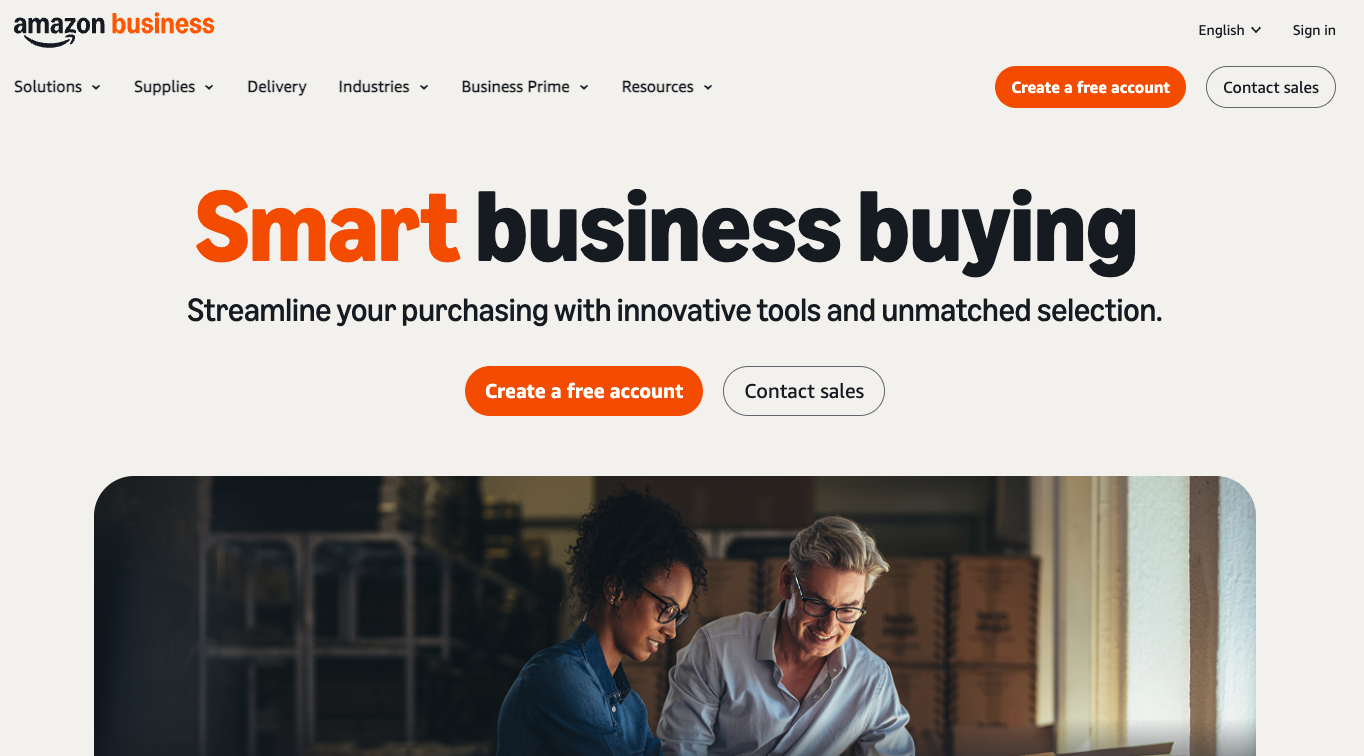
Launched in 2015 and based in Seattle, Amazon Business is the enterprise-facing branch of Amazon’s broader marketplace. It was built to serve organizations that need more than a simple checkout, offering business-only pricing, approval workflows, tax exemptions, and bulk ordering tools.
What sets Amazon Business apart isn’t just its product range, but the infrastructure behind it.
The platform is present in multiple countries and supports a broad variety of industries, from healthcare to manufacturing. With built-in integrations and a familiar interface, it lowers the friction of procurement while allowing sellers to reach new international customers.
As more companies move their supply chains online, Amazon Business remains one of the most recognized marketplace examples in the B2B space, driven by scale, trust, and consistent fulfillment performance.
Ankorstore
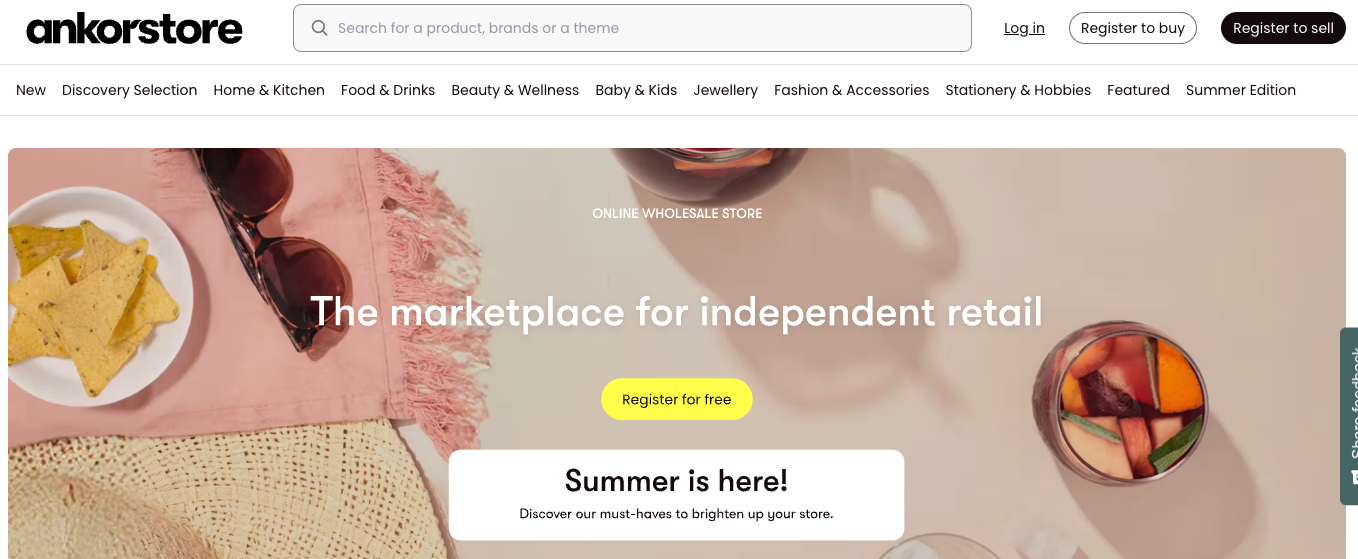
Ankorstore was founded in 2019 and operates out of Paris. It combines independent brands and boutique retailers and has a strong presence across Europe. Far from mass-volume eCommerce marketplaces, Ankorstore focuses on curated, high-quality products, especially in categories like wellness, lifestyle, and home goods.
Its appeal lies in the flexibility it offers to both sides.
Retailers can place low-minimum orders and delay payment, while sellers access a centralized location to grow across multiple countries without managing their own online store.
This structure works well for ethical brands and small businesses looking to connect buyers across borders without sacrificing brand identity. Ankorstore is a marketplace platform designed for discovery and growth, not just distribution.
eWorldTrade

Founded in 2006 and headquartered in Dallas, eWorldTrade is one of the more established B2B marketplaces supporting cross-border trade. It focuses on global expansion for exporters, wholesalers, and manufacturers, helping them reach buyers in sectors like consumer electronics, packaging, agriculture, and textiles.
The platform gives sellers tools to build product listings, showcase catalogs, and interact with leads, all within a system optimized for international transactions.
Many use it to test demand in new regions before committing to a full online business strategy.
Other marketplaces that rely on brand recognition, eWorldTrade competes by offering targeted outreach, verified buyer programs, and access to niche industries often underserved by more general platforms.
It’s a functional option for businesses that want reach without complexity, and a strong example of how digital marketplaces are adapting to the global economy.
Top B2C Marketplace Examples
Etsy
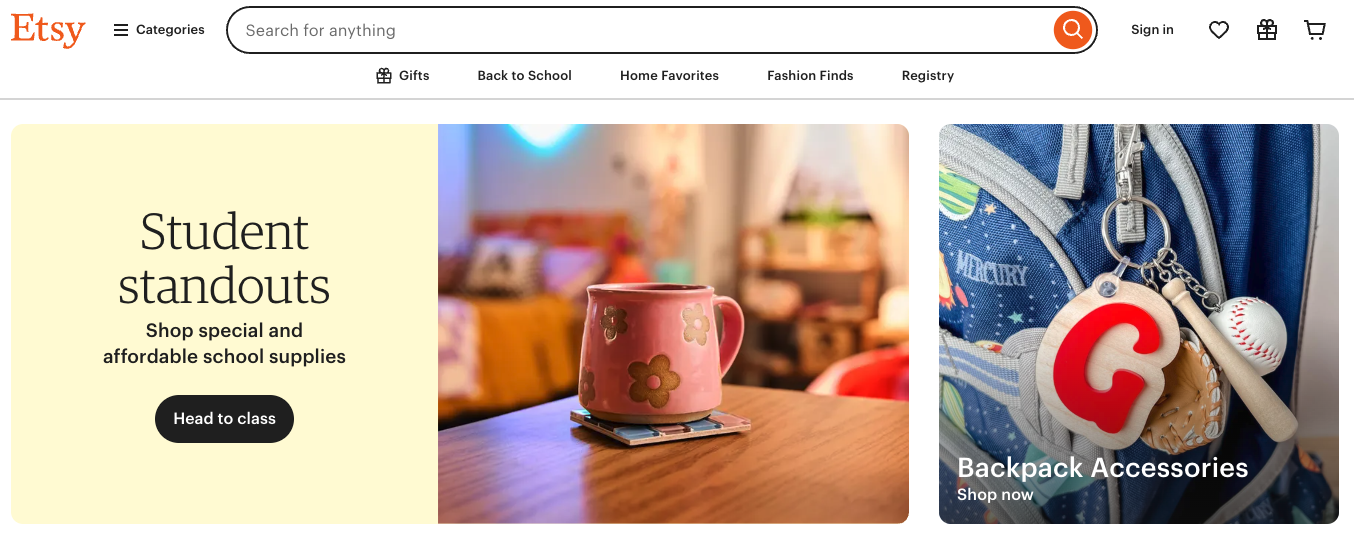
Founded in 2005 and headquartered in Brooklyn, Etsy is a marketplace built around creativity, craftsmanship, and independent sellers.
It was designed to support small businesses and individuals offering handmade and vintage items, art, and niche supplies, turning personal projects into full-scale online businesses.
The platform serves a global customer base and helps buyers discover products that don’t often appear in traditional retail or large ecommerce platforms. Its focus on personalization and storytelling gives each product listing a sense of identity, which helps differentiate it from other digital marketplaces.
Etsy’s business model is built around low entry barriers and tools that help sellers grow gradually.
With strong organic traffic, a simple store setup, and a loyal user base, Etsy has become a go-to B2C marketplace for niche shopping preferences and brands that want more control over their brand identity.
eBay
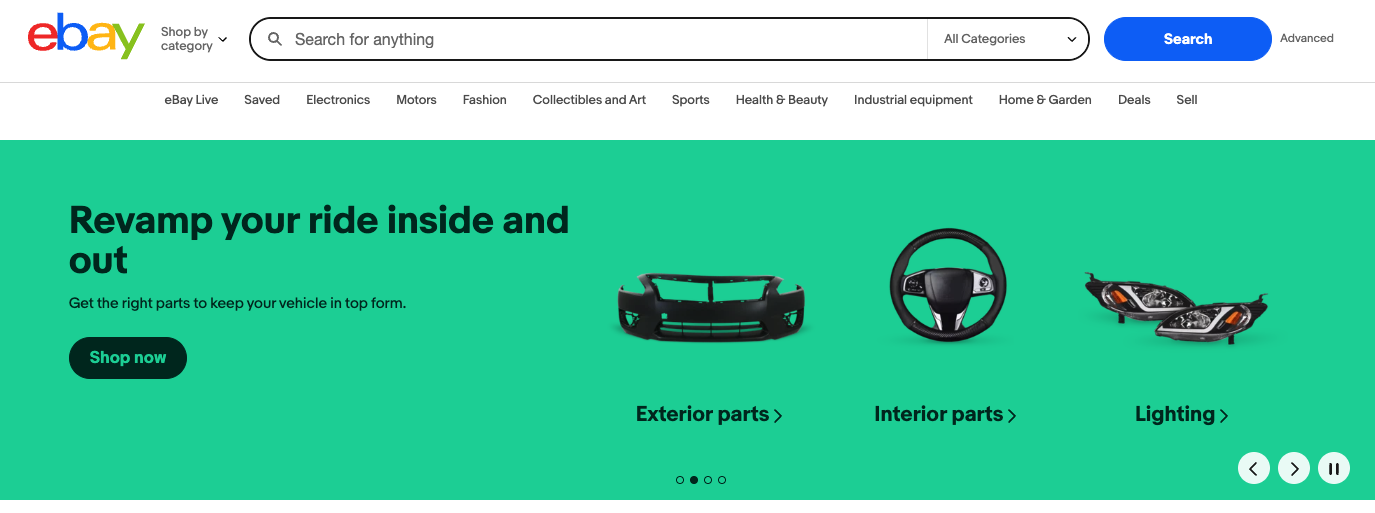
eBay was founded in 1995 and is headquartered in San Jose, California. Initially known for online auctions, the platform has since evolved into a flexible marketplace platform for both fixed-price and bid-based selling of products, from digital goods to refurbished tech and rare collectibles.
With a structure that supports multiple sellers, global payments, and seller ratings, eBay remains a strong player in the best online marketplaces category.
Its reach spans multiple countries, and the platform supports everything from casual sellers to large commercial vendors.
eBay also plays a unique role in allowing resale, upcycling, and liquidation, tapping into consumer preferences for affordability and sustainability. For many users, it combines the feel of a traditional marketplace with the speed of a modern online store, offering access to new and secondhand inventory through one familiar interface.
Facebook Marketplace
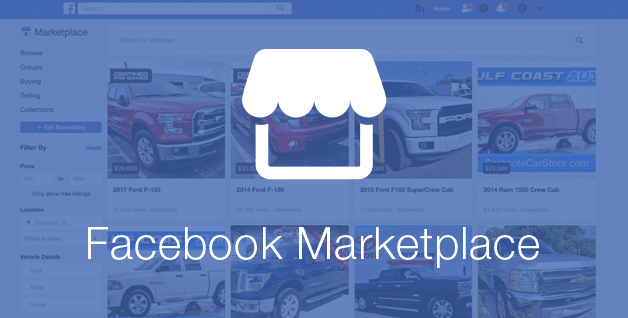
Facebook Marketplace officially launched in 2016, growing out of the organic habit users had developed around local buying and selling through Facebook Groups. Headquartered in Menlo Park, it’s now integrated directly into the Facebook app, giving it immediate reach among millions of users.
Its main focus is on local communities, connecting buyers with sellers nearby for face-to-face exchanges.
But over time, the platform expanded to include business listings, digital goods, and even some national shipping categories, moving closer to other e-commerce marketplaces in structure.
Facebook's online marketplace offers instant access to a massive existing customer base without requiring a standalone storefront or complex setup. It’s especially useful for testing demand in a local target market, listing inventory quickly, or driving sales for independent businesses that want to grow without managing an e-commerce platform of their own.
Top P2P Marketplace Examples
Airbnb
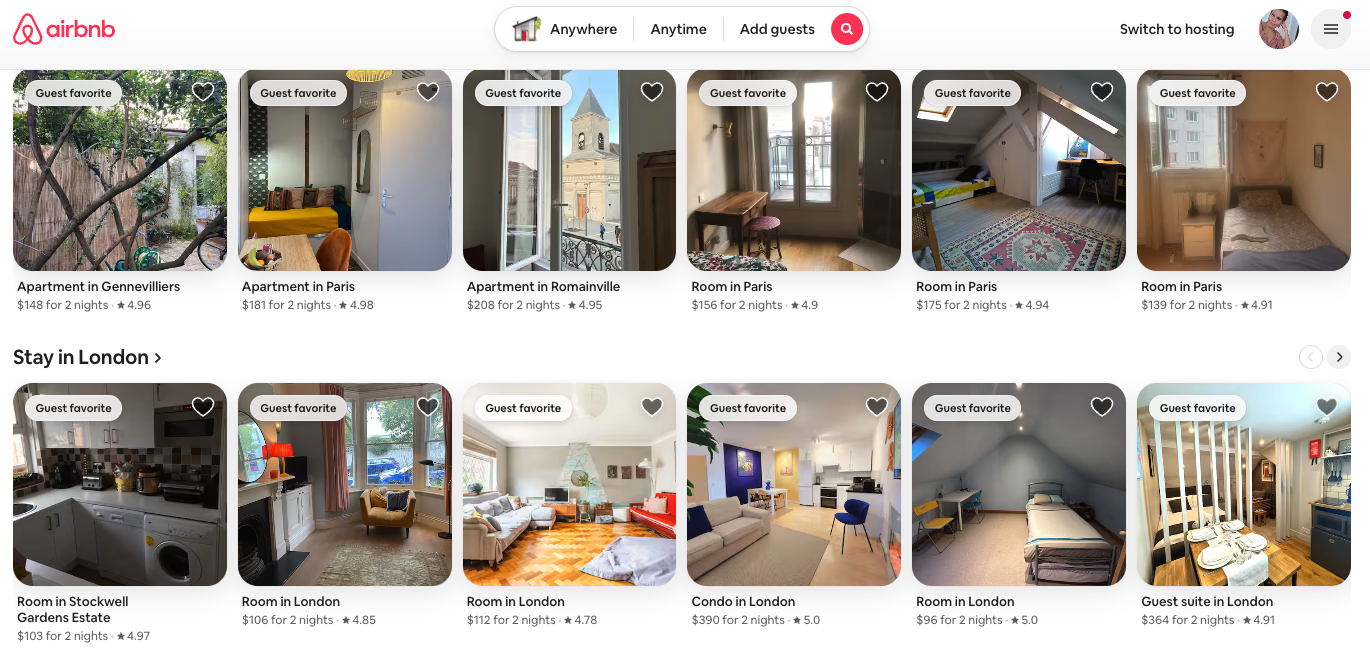
Airbnb began as a way to rent out spare rooms but quickly transformed into a global marketplace platform connecting travelers with private accommodations. Founded in 2008, it is headquartered in San Francisco and now serves over 220 countries and regions.
Its business model is peer-to-peer at its core: hosts list properties, guests book them, and the platform handles payments, profiles, and reviews. That model allowed Airbnb to scale faster than traditional hotel chains and operate without owning any physical inventory.
Key factors like trust systems, clear listing standards, and responsive support shaped the customer experience, helping Airbnb become one of the best online marketplaces in travel.
By building a system that supports casual hosts and full-time operators, it’s also helped many launch their own marketplace-based micro-businesses. With constant international growth, Airbnb is a case study in how P2P digital marketplaces can expand globally without traditional infrastructure.
Upwork
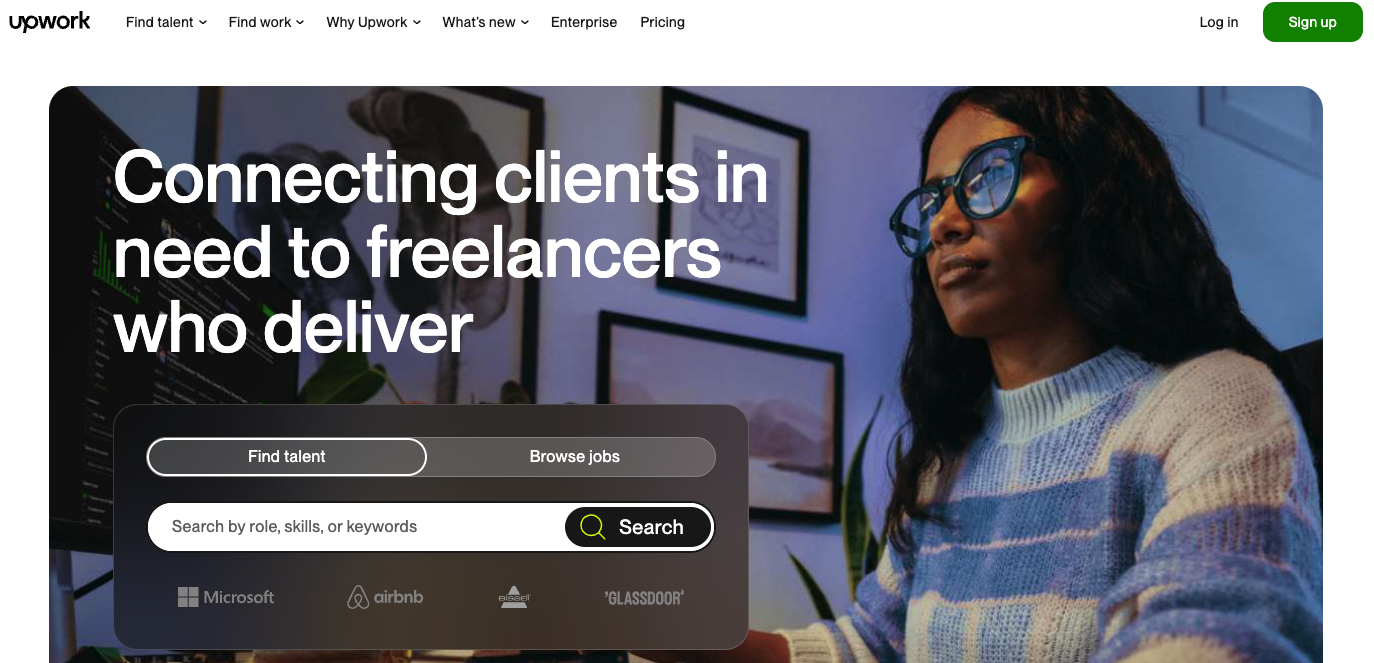
Upwork, headquartered in California, was formed in 2015 through the merger of Elance and oDesk. It’s a service marketplace built to connect freelance professionals with clients seeking digital services, from writing and programming to marketing, design, and consulting.
This online marketplace supports a wide range of categories and has developed tools that help both buyers and sellers manage contracts, payments, and communication.
Its model focuses on long-term client–freelancer relationships, not just one-off tasks.
Upwork competes with job boards but differentiates itself through workflow tools and a structure built specifically for remote collaboration. It continues to grow as companies shift toward flexible, on-demand talent models.
As a market leader in the freelance space, its success shows how a P2P structure can scale into a full-service ecommerce platform without selling physical goods.
Postmates
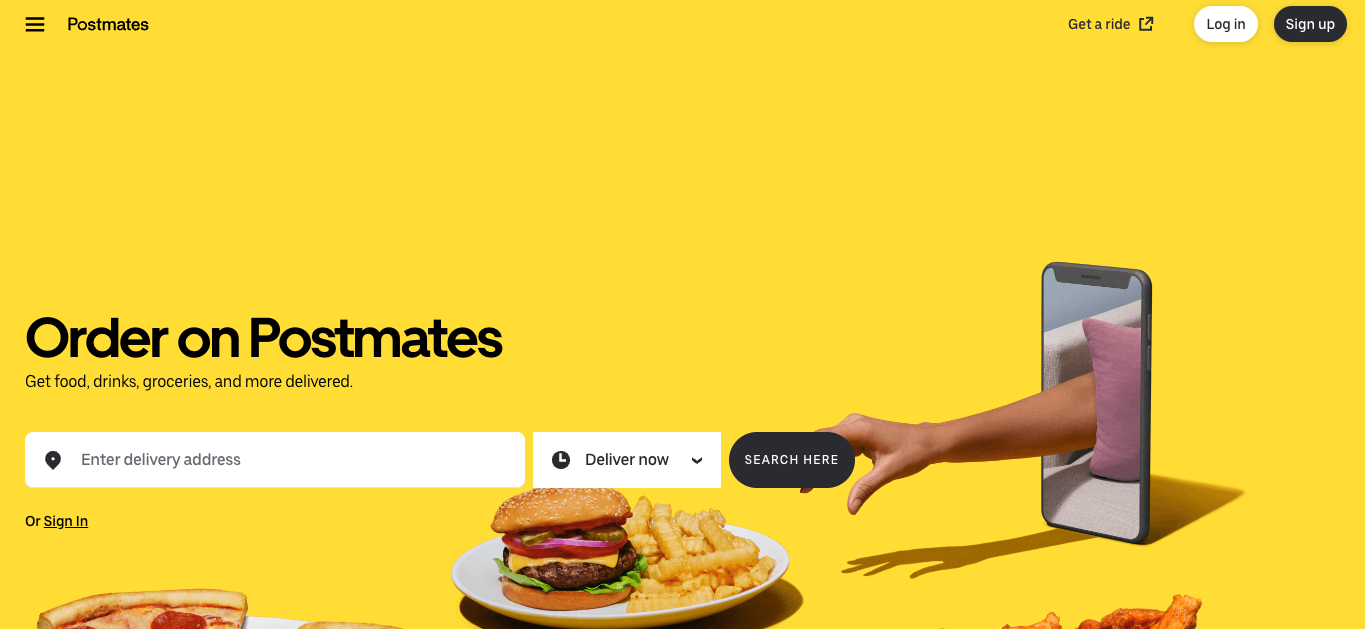
Founded in 2011 and based in San Francisco, Postmates grew into one of the most recognizable names in food delivery before being acquired by Uber in 2020. It operates as a peer-to-peer marketplace, allowing individuals to deliver goods, from meals to groceries, to nearby customers.
The platform connects users through a shared app, assigning delivery requests in real time while optimizing for speed and availability. That structure required a strong logistics infrastructure, but didn’t rely on centralized hubs or warehouses, just a network of couriers.
Its success came from meeting a clear demand with simple execution.
The revenue model is built on delivery fees, service charges, and vendor commissions, allowing scale without owning inventory. As part of the transition toward services online, Postmates remains one of the clearest marketplace examples of how to facilitate physical transactions through a digital-first experience.
Top eCommerce Marketplace Examples
Rakuten

Rakuten, founded in 1997 and based in Tokyo, operates one of the most established e-commerce marketplaces in Asia. It’s often compared to Amazon but takes a different direction, offering tools that allow merchants to personalize storefronts, build loyalty programs, and manage marketing directly.
The platform includes everything from electronics to fashion, and has expanded into credit cards, mobile plans, and travel services. That system facilitates transactions on verticals while supporting buyers and sellers through a unified account system.
With strong brand equity in Japan and a presence in Europe and North America, Rakuten’s global expansion efforts have helped increase the marketplace's reach beyond domestic borders.
Its structure favors careful planning, giving vendors more ownership of customer experience compared to other digital marketplaces.
Allegro

Headquartered in Poland and launched in 1999, Allegro is the most visited online marketplace in Central Europe. It started with electronics and expanded into toys, beauty, home goods, and more, serving millions of users every month.
Allegro’s strength lies in local trust and regional focus.
While many digital marketplaces try to scale globally from day one, Allegro doubled down on Polish-speaking markets and regional logistics first. That decision helped them master fulfillment, shipping, and support before expanding services.
As one of the leading online marketplaces in its geography, it’s often listed among the best online marketplaces in Europe. Its logistics infrastructure is highly localized, allowing quick delivery times and strong service levels across its range of products.
Wish

Wish was founded in 2010 and is headquartered in San Francisco.
It became known for aggressive pricing and a mobile-first experience, targeting budget-conscious shoppers with a wide selection of products from overseas suppliers.
Its business model focuses on variety and affordability, often offering steep discounts on trending consumer goods. While it doesn't cater to a luxury-seeking target market, it appeals to price-driven users looking for alternatives to larger retailers.
Wish’s rise was fueled by direct supplier relationships and a simplified marketplace platform that enabled quick onboarding for new vendors.
Though shipping times vary, the platform prioritizes scale over speed, and its fulfillment process continues to develop as it competes with other global eCommerce platforms.
Top Service Marketplace Examples
Fiverr
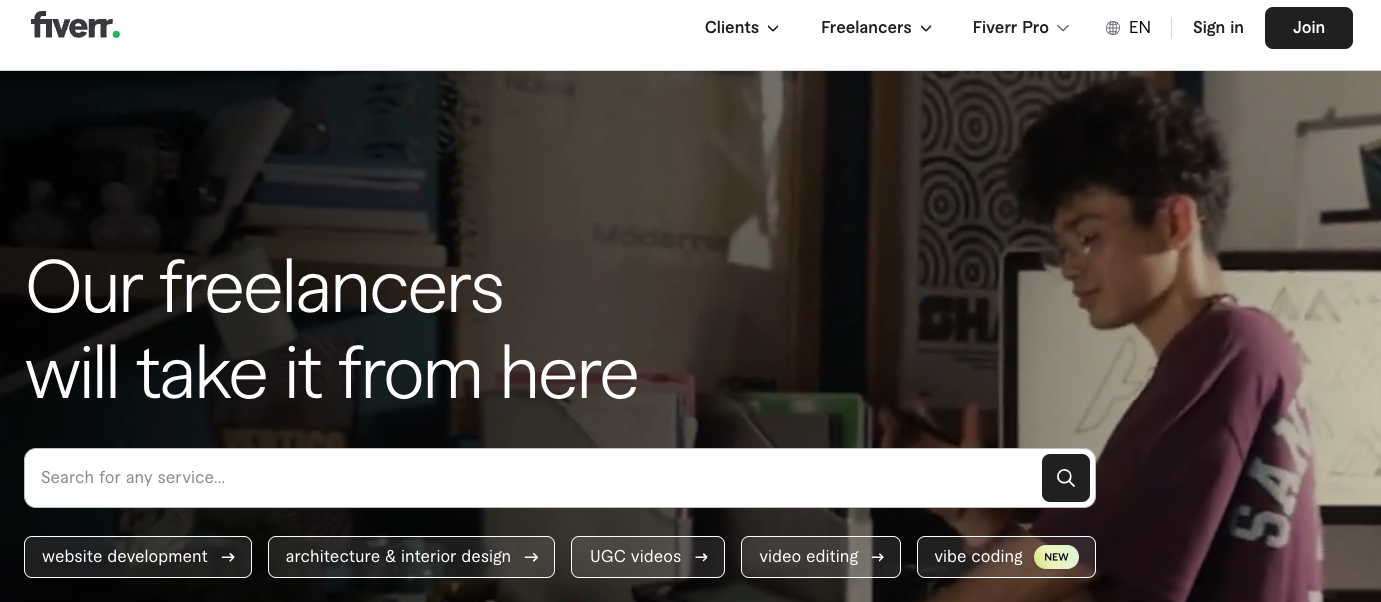
Fiverr is a service marketplace that connects freelancers with clients looking for quick, high-quality work. It’s built around the gig economy, offering opportunities for freelancers to showcase their skills and work with clients worldwide.
The platform stands out for its wide range of services, which include graphic design, writing, programming, and voiceovers. Some freelancers even offer niche technical services like QA testing, giving startups a fast way to validate features before launch.
Freelancers create “gigs” with set prices, making it simple for buyers to browse and choose.
Fiverr has reshaped the changed world by making it accessible to new and experienced professionals. It offers a platform for anyone to turn their skills into income.
Thumbtack

Thumbtack is a service marketplace connecting local professionals with people needing help.
From home repairs to event planning, Thumbtack helps users find the right expert.
What makes Thumbtack special is how it customizes the experience. Users enter their project details, and Thumbtack matches them with local professionals who can handle the job.
For local businesses, it’s a way to reach more clients, while for customers, it’s about finding reliable, skilled professionals without the guesswork. Thumbtack makes hiring for any project simple and stress-free.
It’s also useful when planning local tech projects and figuring out how to make a budget for software development that includes external service providers.
Instacart
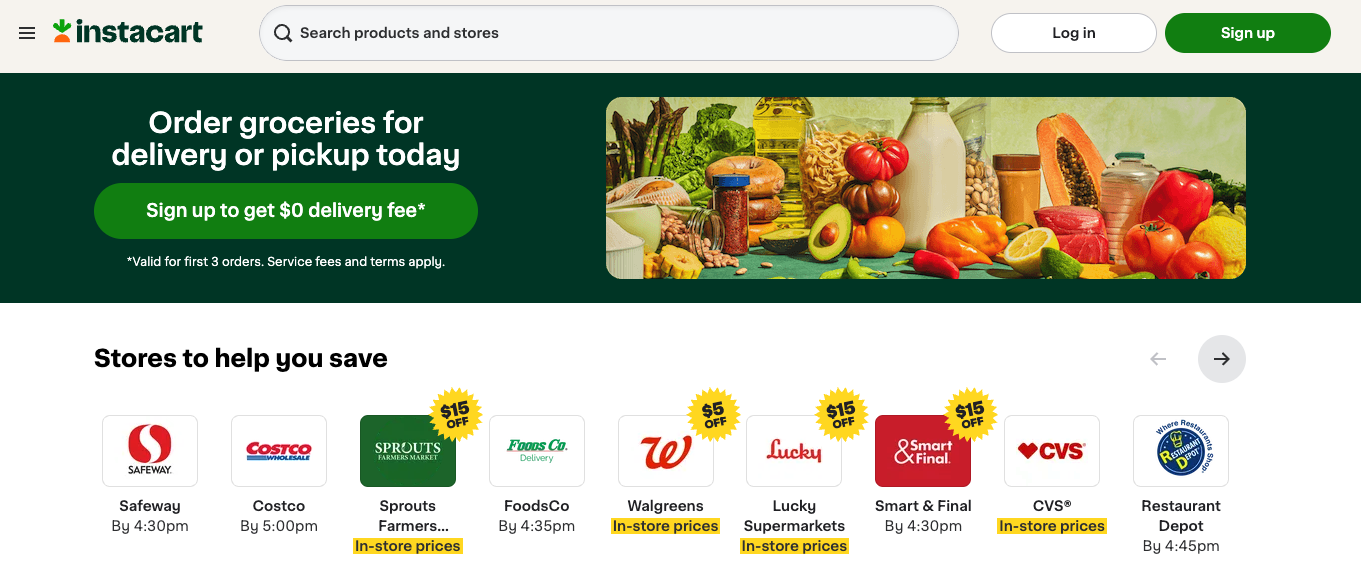
Instacart is a grocery delivery service that delivers your shopping list straight to your door. It partners with supermarkets to allow you to order online and have groceries delivered the same day.
The platform is all about convenience. You browse your local store’s inventory, add items to your cart, and a shopper picks and delivers them.
Instacart has changed grocery shopping by saving time and making it easy to stay stocked without leaving home.
It’s ideal for busy people who want fresh food and essentials without the hassle of a supermarket trip.
Building an Online Marketplace? NerdHeadz Can Help
Creating a marketplace that actually works, for users, vendors, and your team, takes more than just a pretty interface. Every feature must support a two-sided experience that helps buyers and sellers connect, transact, and return.
At NerdHeadz, we develop custom marketplace apps that reflect your strategy and scale with your growth. Whether you're targeting food delivery, job boards, or a product-focused e-commerce platform, we help you define the key aspects of the platform early on so you don't rebuild under pressure later.
You’ll get a full team: developers, designers, and product leads who know what to prioritize in a first release. We guide technical choices around authentication, search, listings, payments, and the fulfillment process without overcomplicating things that don’t yet matter.
We’ve worked with founders building B2B SaaS tools, service-based digital marketplaces, and new takes on traditional marketplace models.
From localized launches to global expansion, we know how to build platforms that scale. We have developed SaaS and eCommerce marketplaces such as:
- GHLASS, a portal that connects fashion designers, influencers, and buyers
- Swans, a luxury beauty artist marketplace
- SalesPipe, an outbound sales development agency
Most of all, we care about quality. That means thoughtful user flows, strong architecture, and careful planning around things like the marketplace's reach, logistics infrastructure, and moderation before they become problems.
You don’t need to copy the best online marketplaces. You need a version that works for your target market, connects users, and earns trust.
We’ll help you build that, and grow it.
Conclusion
The marketplace model continues to determine the way people buy, sell, and deliver value across industries and around the world. From handmade items to food delivery, the ability to connect users in one flexible system remains a powerful business foundation.
But standing out takes more than a list of features. The best platforms reflect clear priorities: structure, simplicity, and a deep understanding of their target market.
If you're planning to build something similar or smarter, NerdHeadz can help. We design and build custom marketplaces that support your strategy, growth, and users.
No noise. Just the right decisions at the right time.
Get in touch and let’s build something your users will trust, and your team can grow with.
Frequently asked questions
What is the best online marketplace to sell on?

The best marketplace depends on what you’re selling. For handmade or unique items, Etsy is great. Amazon suits many products, while eBay works well for collectibles and used items. Choose based on your niche and audience.
What is an example of a popular online marketplace?

A popular online marketplace example is Amazon. It connects millions of buyers and sellers, offering a wide range of products through third-party vendors and its own inventory.
What is the biggest online market in the USA?

Amazon is the most extensive online market in the USA, dominating e-commerce with its wide product range and convenient shopping experience.
What is the highest-selling online platform?

Amazon is the highest-selling platform, generating billions in revenue annually through its robust seller network and loyal customer base.

Luciani Woestemeier
Luciani Zorrilla is a content marketer with experience in sales development, outbound sales, SEO, design, email marketing, and UX. She stands out in driving sustainable growth for tech startups through impactful SEO strategies and leading results-oriented marketing teams.
Related Articles
Subscribe to our Newsletter
.webp)
.webp)
Are you ready to talk about your project?
Schedule a consultation with our team, and we’ll send a custom proposal.


Not all marketplaces succeed, and the ones that do rarely follow the same blueprint.
Some focus on physical goods, others on digital services. Some rely on independent sellers, while others centralize control. What they share is a structure that balances reach, trust, and usability, for both sides of the transaction.
This guide breaks down real marketplace examples across B2B, B2C, P2P, and eCommerce categories. You'll see how different platforms manage listings, payments, and scale, and what sets each model apart.
Whether you're researching competitors or planning to launch your own marketplace through custom software development, these examples offer insight into how online platforms connect users, grow across borders, and stay aligned with user intent in a crowded space.
What is an Online Marketplace?
An online marketplace is a digital platform where different sellers offer goods or services to a shared audience. The marketplace manages product listings, payment options, and the buying experience. For founders building a minimum viable product (MVP), marketplaces offer a fast way to validate demand without building a complex infrastructure from scratch.
Many marketplace platforms also handle logistics, customer support, or fulfillment on behalf of the sellers.
There are five main types of marketplaces:
- Product marketplaces focus on physical items, where independent sellers list consumer electronics, craft supplies, or vintage collections.
- Service marketplaces help users find providers for graphic design, legal help, or food delivery.
- B2B marketplaces connect companies with suppliers, often across multiple countries. These platforms support bulk orders, recurring contracts, and detailed business vetting.
- B2C marketplaces let brands and retailers reach a broader audience without maintaining their own ecommerce platform.
- Vertical marketplaces focus on specific segments, such as job seekers, ethical brands, or independent businesses in local communities.
What makes these platforms effective is their ability to host multiple sellers while maintaining a consistent experience, allowing buyers to compare product quality, pricing, and service within one centralized location.
As demand grows for digital goods and services online, marketplaces help businesses expand globally, reach international customers, and build their customer base without launching multiple websites. Some companies even extend marketplace features into their broader enterprise app development strategies to support vendor networks and internal buying systems.
Top B2B Marketplace Examples
Amazon Business

Launched in 2015 and based in Seattle, Amazon Business is the enterprise-facing branch of Amazon’s broader marketplace. It was built to serve organizations that need more than a simple checkout, offering business-only pricing, approval workflows, tax exemptions, and bulk ordering tools.
What sets Amazon Business apart isn’t just its product range, but the infrastructure behind it.
The platform is present in multiple countries and supports a broad variety of industries, from healthcare to manufacturing. With built-in integrations and a familiar interface, it lowers the friction of procurement while allowing sellers to reach new international customers.
As more companies move their supply chains online, Amazon Business remains one of the most recognized marketplace examples in the B2B space, driven by scale, trust, and consistent fulfillment performance.
Ankorstore

Ankorstore was founded in 2019 and operates out of Paris. It combines independent brands and boutique retailers and has a strong presence across Europe. Far from mass-volume eCommerce marketplaces, Ankorstore focuses on curated, high-quality products, especially in categories like wellness, lifestyle, and home goods.
Its appeal lies in the flexibility it offers to both sides.
Retailers can place low-minimum orders and delay payment, while sellers access a centralized location to grow across multiple countries without managing their own online store.
This structure works well for ethical brands and small businesses looking to connect buyers across borders without sacrificing brand identity. Ankorstore is a marketplace platform designed for discovery and growth, not just distribution.
eWorldTrade

Founded in 2006 and headquartered in Dallas, eWorldTrade is one of the more established B2B marketplaces supporting cross-border trade. It focuses on global expansion for exporters, wholesalers, and manufacturers, helping them reach buyers in sectors like consumer electronics, packaging, agriculture, and textiles.
The platform gives sellers tools to build product listings, showcase catalogs, and interact with leads, all within a system optimized for international transactions.
Many use it to test demand in new regions before committing to a full online business strategy.
Other marketplaces that rely on brand recognition, eWorldTrade competes by offering targeted outreach, verified buyer programs, and access to niche industries often underserved by more general platforms.
It’s a functional option for businesses that want reach without complexity, and a strong example of how digital marketplaces are adapting to the global economy.
Top B2C Marketplace Examples
Etsy

Founded in 2005 and headquartered in Brooklyn, Etsy is a marketplace built around creativity, craftsmanship, and independent sellers.
It was designed to support small businesses and individuals offering handmade and vintage items, art, and niche supplies, turning personal projects into full-scale online businesses.
The platform serves a global customer base and helps buyers discover products that don’t often appear in traditional retail or large ecommerce platforms. Its focus on personalization and storytelling gives each product listing a sense of identity, which helps differentiate it from other digital marketplaces.
Etsy’s business model is built around low entry barriers and tools that help sellers grow gradually.
With strong organic traffic, a simple store setup, and a loyal user base, Etsy has become a go-to B2C marketplace for niche shopping preferences and brands that want more control over their brand identity.
eBay

eBay was founded in 1995 and is headquartered in San Jose, California. Initially known for online auctions, the platform has since evolved into a flexible marketplace platform for both fixed-price and bid-based selling of products, from digital goods to refurbished tech and rare collectibles.
With a structure that supports multiple sellers, global payments, and seller ratings, eBay remains a strong player in the best online marketplaces category.
Its reach spans multiple countries, and the platform supports everything from casual sellers to large commercial vendors.
eBay also plays a unique role in allowing resale, upcycling, and liquidation, tapping into consumer preferences for affordability and sustainability. For many users, it combines the feel of a traditional marketplace with the speed of a modern online store, offering access to new and secondhand inventory through one familiar interface.
Facebook Marketplace

Facebook Marketplace officially launched in 2016, growing out of the organic habit users had developed around local buying and selling through Facebook Groups. Headquartered in Menlo Park, it’s now integrated directly into the Facebook app, giving it immediate reach among millions of users.
Its main focus is on local communities, connecting buyers with sellers nearby for face-to-face exchanges.
But over time, the platform expanded to include business listings, digital goods, and even some national shipping categories, moving closer to other e-commerce marketplaces in structure.
Facebook's online marketplace offers instant access to a massive existing customer base without requiring a standalone storefront or complex setup. It’s especially useful for testing demand in a local target market, listing inventory quickly, or driving sales for independent businesses that want to grow without managing an e-commerce platform of their own.
Top P2P Marketplace Examples
Airbnb

Airbnb began as a way to rent out spare rooms but quickly transformed into a global marketplace platform connecting travelers with private accommodations. Founded in 2008, it is headquartered in San Francisco and now serves over 220 countries and regions.
Its business model is peer-to-peer at its core: hosts list properties, guests book them, and the platform handles payments, profiles, and reviews. That model allowed Airbnb to scale faster than traditional hotel chains and operate without owning any physical inventory.
Key factors like trust systems, clear listing standards, and responsive support shaped the customer experience, helping Airbnb become one of the best online marketplaces in travel.
By building a system that supports casual hosts and full-time operators, it’s also helped many launch their own marketplace-based micro-businesses. With constant international growth, Airbnb is a case study in how P2P digital marketplaces can expand globally without traditional infrastructure.
Upwork

Upwork, headquartered in California, was formed in 2015 through the merger of Elance and oDesk. It’s a service marketplace built to connect freelance professionals with clients seeking digital services, from writing and programming to marketing, design, and consulting.
This online marketplace supports a wide range of categories and has developed tools that help both buyers and sellers manage contracts, payments, and communication.
Its model focuses on long-term client–freelancer relationships, not just one-off tasks.
Upwork competes with job boards but differentiates itself through workflow tools and a structure built specifically for remote collaboration. It continues to grow as companies shift toward flexible, on-demand talent models.
As a market leader in the freelance space, its success shows how a P2P structure can scale into a full-service ecommerce platform without selling physical goods.
Postmates

Founded in 2011 and based in San Francisco, Postmates grew into one of the most recognizable names in food delivery before being acquired by Uber in 2020. It operates as a peer-to-peer marketplace, allowing individuals to deliver goods, from meals to groceries, to nearby customers.
The platform connects users through a shared app, assigning delivery requests in real time while optimizing for speed and availability. That structure required a strong logistics infrastructure, but didn’t rely on centralized hubs or warehouses, just a network of couriers.
Its success came from meeting a clear demand with simple execution.
The revenue model is built on delivery fees, service charges, and vendor commissions, allowing scale without owning inventory. As part of the transition toward services online, Postmates remains one of the clearest marketplace examples of how to facilitate physical transactions through a digital-first experience.
Top eCommerce Marketplace Examples
Rakuten

Rakuten, founded in 1997 and based in Tokyo, operates one of the most established e-commerce marketplaces in Asia. It’s often compared to Amazon but takes a different direction, offering tools that allow merchants to personalize storefronts, build loyalty programs, and manage marketing directly.
The platform includes everything from electronics to fashion, and has expanded into credit cards, mobile plans, and travel services. That system facilitates transactions on verticals while supporting buyers and sellers through a unified account system.
With strong brand equity in Japan and a presence in Europe and North America, Rakuten’s global expansion efforts have helped increase the marketplace's reach beyond domestic borders.
Its structure favors careful planning, giving vendors more ownership of customer experience compared to other digital marketplaces.
Allegro

Headquartered in Poland and launched in 1999, Allegro is the most visited online marketplace in Central Europe. It started with electronics and expanded into toys, beauty, home goods, and more, serving millions of users every month.
Allegro’s strength lies in local trust and regional focus.
While many digital marketplaces try to scale globally from day one, Allegro doubled down on Polish-speaking markets and regional logistics first. That decision helped them master fulfillment, shipping, and support before expanding services.
As one of the leading online marketplaces in its geography, it’s often listed among the best online marketplaces in Europe. Its logistics infrastructure is highly localized, allowing quick delivery times and strong service levels across its range of products.
Wish

Wish was founded in 2010 and is headquartered in San Francisco.
It became known for aggressive pricing and a mobile-first experience, targeting budget-conscious shoppers with a wide selection of products from overseas suppliers.
Its business model focuses on variety and affordability, often offering steep discounts on trending consumer goods. While it doesn't cater to a luxury-seeking target market, it appeals to price-driven users looking for alternatives to larger retailers.
Wish’s rise was fueled by direct supplier relationships and a simplified marketplace platform that enabled quick onboarding for new vendors.
Though shipping times vary, the platform prioritizes scale over speed, and its fulfillment process continues to develop as it competes with other global eCommerce platforms.
Top Service Marketplace Examples
Fiverr

Fiverr is a service marketplace that connects freelancers with clients looking for quick, high-quality work. It’s built around the gig economy, offering opportunities for freelancers to showcase their skills and work with clients worldwide.
The platform stands out for its wide range of services, which include graphic design, writing, programming, and voiceovers. Some freelancers even offer niche technical services like QA testing, giving startups a fast way to validate features before launch.
Freelancers create “gigs” with set prices, making it simple for buyers to browse and choose.
Fiverr has reshaped the changed world by making it accessible to new and experienced professionals. It offers a platform for anyone to turn their skills into income.
Thumbtack

Thumbtack is a service marketplace connecting local professionals with people needing help.
From home repairs to event planning, Thumbtack helps users find the right expert.
What makes Thumbtack special is how it customizes the experience. Users enter their project details, and Thumbtack matches them with local professionals who can handle the job.
For local businesses, it’s a way to reach more clients, while for customers, it’s about finding reliable, skilled professionals without the guesswork. Thumbtack makes hiring for any project simple and stress-free.
It’s also useful when planning local tech projects and figuring out how to make a budget for software development that includes external service providers.
Instacart

Instacart is a grocery delivery service that delivers your shopping list straight to your door. It partners with supermarkets to allow you to order online and have groceries delivered the same day.
The platform is all about convenience. You browse your local store’s inventory, add items to your cart, and a shopper picks and delivers them.
Instacart has changed grocery shopping by saving time and making it easy to stay stocked without leaving home.
It’s ideal for busy people who want fresh food and essentials without the hassle of a supermarket trip.
Building an Online Marketplace? NerdHeadz Can Help
Creating a marketplace that actually works, for users, vendors, and your team, takes more than just a pretty interface. Every feature must support a two-sided experience that helps buyers and sellers connect, transact, and return.
At NerdHeadz, we develop custom marketplace apps that reflect your strategy and scale with your growth. Whether you're targeting food delivery, job boards, or a product-focused e-commerce platform, we help you define the key aspects of the platform early on so you don't rebuild under pressure later.
You’ll get a full team: developers, designers, and product leads who know what to prioritize in a first release. We guide technical choices around authentication, search, listings, payments, and the fulfillment process without overcomplicating things that don’t yet matter.
We’ve worked with founders building B2B SaaS tools, service-based digital marketplaces, and new takes on traditional marketplace models.
From localized launches to global expansion, we know how to build platforms that scale. We have developed SaaS and eCommerce marketplaces such as:
- GHLASS, a portal that connects fashion designers, influencers, and buyers
- Swans, a luxury beauty artist marketplace
- SalesPipe, an outbound sales development agency
Most of all, we care about quality. That means thoughtful user flows, strong architecture, and careful planning around things like the marketplace's reach, logistics infrastructure, and moderation before they become problems.
You don’t need to copy the best online marketplaces. You need a version that works for your target market, connects users, and earns trust.
We’ll help you build that, and grow it.
Conclusion
The marketplace model continues to determine the way people buy, sell, and deliver value across industries and around the world. From handmade items to food delivery, the ability to connect users in one flexible system remains a powerful business foundation.
But standing out takes more than a list of features. The best platforms reflect clear priorities: structure, simplicity, and a deep understanding of their target market.
If you're planning to build something similar or smarter, NerdHeadz can help. We design and build custom marketplaces that support your strategy, growth, and users.
No noise. Just the right decisions at the right time.
Get in touch and let’s build something your users will trust, and your team can grow with.

Luciani Zorrilla is a content marketer with experience in sales development, outbound sales, SEO, design, email marketing, and UX. She stands out in driving sustainable growth for tech startups through impactful SEO strategies and leading results-oriented marketing teams.

%201.svg)

%201.svg)
%201.webp)

%201.webp)








